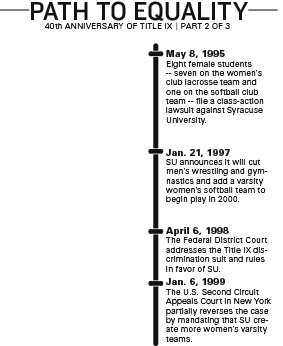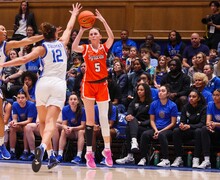Recognition, significance of 1995 Title IX lawsuit filed by eight women against SU forgotten over time
/ The Daily Orange
No student ever expects to be in a legal battle against the university he or she attends. But about 15 years ago, that’s where eight female students at Syracuse University found themselves.
“Looking back, I was thinking, ‘I can’t believe I did that,’” said Alexis Braunfeld, a 1997 SU graduate. “But we just wanted a lacrosse team and thought this was a good way to get it and get some attention on it, and get the team in place. In hindsight, I can’t believe that I would go against the school that I love so much and had a great time at.”
Braunfeld was Alexis Snader then. She was a member of the women’s club lacrosse team.
Braunfeld and seven other female students — six on the club lacrosse team and one on the softball club team — filed a class-action lawsuit against SU on May 8, 1995. The suit claimed the university’s athletic department was discriminating against female student-athletes and was violating Title IX. It also asked a judge to immediately elevate women’s lacrosse from club to varsity status.
In 1998, the Federal District Court addressed the lawsuit and ruled in favor of SU. But the ruling was appealed to the U.S. Second Circuit Appeals Court in New York. On Jan. 6, 1999, the court — three justices including Sonia Sotomayor — partially reversed the case by mandating that SU create more women’s varsity teams. By that time, the university already created women’s varsity lacrosse and soccer teams. Softball was on its way.
Many SU officials admit they’ve never heard of this suit. It’s been forgotten over time, and the suit’s effect remains in question.
Critics say the case was insignificant, as the university was already in the process of adding women’s sports. Others say the lawsuit prompted the university to take action. The only sure things are the facts: The suit was filed in 1995, and by 2000, women’s soccer, lacrosse and softball were added, while men’s gymnastics and wrestling were on their way out.
The Federal District Court ruling marked the first time a university had ever won a Title IX lawsuit filed by women athletes.
Mary Dee Wenniger has been editor of Women in Higher Education, a monthly news journal looking to “enlighten, encourage, empower and enrage women on campus,” for 21 years.
“The significance is Syracuse University did something right,” Wenniger said of the case. “I can’t remember another school that has escaped punishment.
“The reason the school got off the hook is that it had continued to showcase that it upgraded women’s activities,” she added.
The university was able to prove that to the Federal District Court without adding a single women’s team from 1982 to 1995.
SU increased scholarships for women athletes, improved facilities and enhanced the coaching staffs. During those 13 years, female participation rose 47 percent with an increase of 69 varsity opportunities. Participation in men’s sports increased 3 percent.
Therefore, the Federal District Court said the university was in compliance with Title IX based on a sufficient history of expanding opportunities for women athletes.
But the briefs filed with the U.S. Second Circuit Appeals Court on April 3, 1998, called the court’s finding “totally erroneous” for failing to consider SU’s undergraduate enrollment.
The 1972 Educational Amendments Act states that universities that receive federal aid must have a gender ratio in the school’s varsity programs that mirrors the ratio in the undergraduate student body.
In 1982, the briefs state, the SU student body was 60 percent male and 40 percent female. By 1996, women made up 51 percent of undergraduate enrollment, according to the briefs. From 1982 to 1995, the disparity in athletic opportunities for women compared to their enrollment actually increased from 19 to 21 percent, the briefs state.
When the lawsuit was filed in 1995, there were 11 varsity sports for men and nine for women. The teams consisted of 360 male athletes compared to 155 female athletes.
That was about to change.
The SU athletic department initiated the creation of women’s varsity soccer and lacrosse teams before the lawsuit was filed, SU defense attorney Edward Conan told The Daily Orange in January 1999.
“It was several months after the plan began being implemented that these students sued seeking immediate implementation of the lacrosse team,” Conan said.
But the athletic department promised women’s varsity teams for more than a decade before the lawsuit prompted them to take action, Faith Seidenberg, the students’ attorney, said in the same article.
“They made press releases saying that the teams were going to be made,” she said. “But when disgruntled students questioned them, the university was saying the teams weren’t going to be made.”
Jake Crouthamel, SU athletic director from 1978 to 2005, claimed at the time he had “no recollection” of any female student seeking to attempt elevation of her club team to varsity status, the appellants’ briefs state.
But four affidavits from female students who claimed to have personally requested that the university elevate their respective clubs to varsity status prove otherwise.
Jennifer Boucher, who was captain of the women’s club lacrosse team, stated in her affidavit that Crouthamel never made her aware of the Athletic Policy Board, which handles proposals looking to elevate a club team’s status. The affidavits from three other students told similar stories, claiming athletic officials told them there was nothing they could do to have their club team’s status raised.
The Second Circuit Appeals Court partially reversed the case on Jan. 6, 1999, by requiring SU to create more women’s varsity teams. By then, though, most of the creating was already done.
As the lawsuit flew under the radar, women’s soccer was added in 1996, women’s lacrosse began in 1997 and softball was instated in 2000. SU also announced in January 1997 that it was cutting men’s wrestling and gymnastics to move closer to compliance with Title IX.
The university fielded 12 women’s sports and nine men’s sports when everything was said and done. By that time, all eight female students had already graduated.
More than 13 years later, the significance of their lawsuit is still unclear.
David Bennett, a history professor who has been at SU since 1961, was the chairman of the Athletic Policy Board and the NCAA Faculty Representative from 1975 to 1995.
During his last years as chairman, Bennett said, the university was talking about adding women’s lacrosse and soccer. The addition of women’s sports was happening across the country because of Title IX, he said.
“I don’t think that lawsuit was connected to the fact that Syracuse was going to expand its athletic programs,” Bennett said. “It may have had some stimulating effect from one year to the next, but it was going to happen inevitably.”
Crouthamel recalls making the difficult call to cut men’s gymnastics and wrestling in 1997. He remembers the nasty letters and alumni outcry, especially from the SU wrestling community.
Even Boucher, who was considered the lead student in the lawsuit against SU, told The Daily Orange in January 1997 that she never thought equality would come from eliminating other sports.
“But you got to do what you got to do,” Crouthamel said in a phone interview.
Adding the three women’s sports was what Crouthamel and the university had to do to comply with Title IX. While many were upset with the elimination of two men’s programs, Crouthamel believes the addition of the women’s sports was quietly appreciated.
“Not to my recollection did I get any phone calls saying, ‘Hey, you’re doing a good job,’” Crouthamel said. “I mean it was a job we should have been doing and finally did. But it was obviously the right thing. It was a requirement, but it was also the right thing to do.”
Today, SU has seven men’s sports compared to 11 women’s sports. It’s a change from when Crouthamel began his 27-year career at SU in 1978 and from when the eight female students filed the lawsuit against the university on May 8, 1995.
“Women’s athletics at the collegiate level has become quite something to their credit,” Crouthamel said. “They’re a part of the team now.”
Published on October 2, 2012 at 3:03 am
Contact Jon: jdharr04@syr.edu






